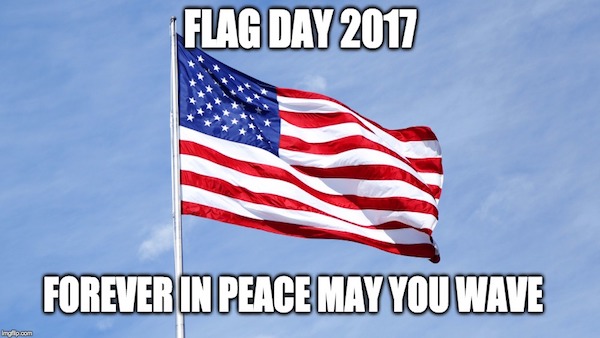I Pledge Allegiance to the flag of the United States of America
and to the Republic for which it stands, one Nation under God,
indivisible, with liberty and justice for all.
Today, June 14th is Flag Day. It commemorates the adoption of the flag of the United States, which happened 240 years ago on June 14, 1777 by resolution of the Second Continental Congress.

This holiday had a very rough start. In 1861, at the start of the Civil War, a man named George Morris persuaded his city of Hartford, Conn., to undertake a patriotic celebration on behalf of the Union. But the concept didn’t catch on, there or elsewhere.
Decades later, in 1885, a 19-year-old Waubeka schoolteacher named Bernard Cigrand plunked a small flag into an inkwell on his desk and assigned his students to write essays on patriotism. Later he traveled the country to promote respect for the flag, becoming president of the American Flag Day Association.

1888, William Kerr, son of a Civil War veteran, founded the American Flag Day Association of Western Pennsylvania, pressing presidents and legislators to make Flag Day official. In his home town of Rennersdale, near Pittsburgh, a historical marker honors Kerr as the “Father of Flag Day.”
In 1889, New York City principal George Bolch had his school hold patriotic ceremonies to observe the day. State officials later expanded the program. In 1893, Elizabeth Duane Gillespie, head of the Colonial Dames of Pennsylvania, worked to have public buildings in Philadelphia display flags – an effort that led one federal office to credit Philadelphia as Flag Day’s original home.
 |
| American Flag 1861 |
Still, Flag Day struggled for official respect. It wasn’t until 1916 that President Woodrow Wilson issued a wishy-washy proclamation to “suggest and request. . . if possible” that people observe Flag Day. Thirty-three years later, in 1949, President Harry S. Truman signed an act passed by Congress naming Flag Day as June14th.
Today Saluting the Flag or even being patriotic seems to some corny or even jingoistic, but when America is challenged we pull together. In the face of horror, Old Glory has alway’s been a rallying point for all Americans. It has helped us deal with national tragedies, after 9/11 for example:

It unified the country after the Boston Marathon bombing (for one day everyone cheered the Red Sox):

Old Glory even helps America to celebrate some of her greatest achievements.

Do you believe in miracles ?

Ten Things You May Not Know About the American Flag:
1. The flag predates the Constitution. The flag was authorized by the Continental Congress on June 14, 1777. The motion read, “Resolved that the flag of the thirteen United States be 13 stripes alternate red and white: that the union be 13 stars, white in a blue field, representing a new constellation.” The Constitution was written 10 years after that and ratified in 1789.
2. What’s the deal with Betsy Ross? Historians are still debating Betsy’s role in designing the first flag, but she recounted that she was asked to sew the flag by her fellow churchgoer, George Washington. Ross had also done some seamstress work for Washington. You can read the debates online, but here’s what the historic marker in front of her house says: “Credited with making the first stars and stripes flag, Ross was a successful upholsterer. She produced flags for the government for over 50 years. As a skilled artisan, Ross represents the many women who supported their families during the Revolution and early Republic.”
3. What exactly is a vexillologist? A vexillologist is a flag expert. It’s a relatively new word, coming into use in 1959. According to the North American Vexillological Association, there are currently no degrees offered on the subject.
4. Who approves design changes in the flag? Congress and the president have ordered design changes in the past to accommodate the addition of new states. President James Monroe and Congress agreed in 1818 that there should be 13 stripes as well as one star for each state in the Union.
5. Who decides the rules for flag etiquette? It’s in the federal code as Chapter 1 of Title 4. The law also includes the approved text of the Pledge of Allegiance.
6. Where outside the United States can you see the flag continuously 24 hours a day? There are five American flags flying on the moon, thanks to the Apollo astronauts. You may not be able to see markings on them, though; they have mostly likely turned white over the years.
7. Which flag had the snake on it? You’ve probably seen the yellow flag with a coiled rattlesnake and the motto “Don’t Tread On Me.” This is the Gadsden flag, named after its designer, General Christopher Gadsden. The flag was used in the Revolutionary War. There are other variations of the flag with rattlesnakes and versions of the motto. Benjamin Franklin was one of the originators of the snake as an American political symbol, in a famous 1754 political cartoon.
8. Where was the first flag flown outside the U.S. in a military action? It was first flown over the shores of Tripoli. The Marines were involved in military actions against the Barbary pirates and after they hit the shore, they raised the Stars and Stripes. After the Battle of Derne in 1805, the flag was raised on foreign soil for the first time after a battle.

The Star Spangled Banner: The Flag That Inspired The Nation Anthem
9. What is Francis Scott Key’s flag connection? Key witnessed the American flag flying after a British attack on Fort McHenry in Baltimore in 1814, while he was a guest on a British ship as he negotiated for the return of American prisoners. His experience inspired him to write a poem, “Defence of Fort McHenry.” After it was published, Key matched it up with music from a popular British tune, which eventually became “The Star-Spangled Banner,” our national anthem. By the way, if “vexillology” wasn’t enough fun, here’s another one: the act of adding new lyrics to an existing song is called “contrafactum.”
10. What’s the biggest American flag? It’s so big you can’t fly it, but the “Superflag” conceived of by the late Thomas Demski measures 505 by 225 feet and weighs 3,000 pounds. It takes 600 people to unfurl. Each star is 17 feet high. Bonus fact: The National Constitution Center in Philadelphia has its own giant American flag on display in its Grand Hall Overlook, surrounded by the flags of all the U.S. states and territories and with the iconic Independence Hall in the background. The flag has flown over the capitals of all 50 states and was hung by Muhammad Ali in a special Flag Day ceremony on June 14, 2003, when the museum opened.

You’re A Grand Old Flag
By George M Cohan
You’re a grand old flag,
You’re a high flying flag
And forever in peace may you wave.
You’re the emblem of
The land I love.
The home of the free and the brave.
Ev’ry heart beats true
‘neath the Red, White and Blue,
Where there’s never a boast or brag.
Should auld acquaintance be forgot,
Keep your eye on the grand old flag.
You’re a grand old flag,
You’re a high flying flag
And forever in peace may you wave.
You’re the emblem of
The land I love.
The home of the free and the brave.
Ev’ry heart beats true
‘neath the Red, White and Blue,
Where there’s never a boast or brag.
Should auld acquaintance be forgot,
Keep your eye on the grand old flag.
Happy Birthday, Old Glory
g
















